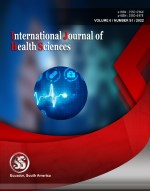To study the association and significance of hyponatremia in pneumonia in paediatric patients in Rims, Raichur
Keywords:
pneumonia, hospital acquired, hyponatraemiaAbstract
Introduction: Hyponatraemia is reported to be the most frequently occurring electrolyte imbalance which is most commonly seen in critically ill children. The aim and objective of this study was to find out the frequency of hyponatremia in pneumonia and to find the association and significance of hyponatremia in patients affected with Pneumonia. Materials and Methodology: This study has been designed as an in-patient hospital based prospective study will be conducted to evaluate the association and significance of hyponatremia in Paediatric patients affected Pneumonia being treated in RIMS, Raichur. 120 patients will be selected as the study participants for the study after obtaining informed consent from the parents as well. Statistical analysis should be carried out by using appropriate statistical tests. Both the groups have to be compared by the student t – test for continuous variables and Chi-square/ Fischer’s exact test for all the categorical variables. The p value of less than 0.05 will be taken as significant. The data will be analysed by statistical software SPSS latest version. Results: . The patient’s serum sodium level ranged from 124 - 145 mEq/L (both found at 0 hour) and none were observed to have hypernatraemia.
Downloads
References
Anderson RJ, Chung Hsiao Min, Kluge R, Schrier RW. Hyponatremia: a prospective analysis of its epidemiology and the pathogenic role of vasopressin. Ann Intern Med 1985; 102: 164-8.
Moritz ML, Ayus JC. Disorders of water metabolism in children: hyponatremia and hypernatremia. Pediatr Rev 2002; 23: 371-80.
Laczi F. Etiology, diagnostics and therapy of hypo - natremias. Orv Hetil 2008; 149: 1347-54.
Lussky HO, Friedstein H. Water retention in pneumonia. Am J Dis Child 1920; 19: 337-43.
Darrow DC, Hartmann AF. Chemical changes occurring in the body as a result of certain diseases. IV. Primary pneumonia in children. Am J Dis Child 1929; 37: 323-34.
Rivers RP, Forsling ML, Olver RP. Inappropriate secretion of anti-diuretic hormone in infants with respiratory infections. Arch Dis Child 1981; 56: 358-63.
Kaplan SL, Feigin RD. The syndrome of inappropriate secretion of antidiuretic hormone in children with bacterial meningitis. J Pediatr 1978; 92: 758-61.
Ellison DH, Berl T. Clinical Practice. The syndrome of inappropriate antidiuresis. N Engl J Med 2007; 356: 2064-72.
Eboriadou M, Haidopoulou K, Xanthou P, Papa A. Coronaviruses OC43 and 229E lower respiratory tract co-infections: a clinical report of two cases. Arch Med Sci 2008; 4: 88-90.
Singhi S, Dhawan A, Frequency and significance of electrolyte abnormalities in pneumonia. Indian Pediatr 1992; 29:735–40.
Dhawan A, Narang A, Singhi S Hyponatraemia and the inappropriate ADH syndrome in pneumonia. Ann Trop Paediatr 1992;12: 455–62.
Don M, Valerio G, Korppi M, Canciani M Hyponatremia in pediatric community-acquired pneumonia.Pediatr Nephrol 2008; 23:2247–53.
Shann F, Germer S Hyponatraemia associated with pneumonia or bacterial meningitis. Arch Dis Child 1985; 60:963–6.
Hua L, Shou-bin Z, Wei-ling Z. Hospital of Bao′an District, Shenzhen 518101, China infants with respiratory infections The Relation between Severe Pneumonia and Hyponatremia or Acidosis in Children (Report of 47 Cases) practical journal of cardiac cerebral pneumal and vascular disease. 2006-02-017.
Rosenow, E.C., Segar, W.E. and Zehr, J.E. Inappropriate antidiuretic hormone secretion in pneumonia, Mayo Clinic Proceedings, 1972; 47: 169.
Nair V, Niederman MS, Masani N, Fishbane S Hyponatremia in community-acquired pneumonia. Am J Nephrol 2007; 27:184–90.
Tierney WM, Martin DK, Greenlee MC, Zerbe RL, McDonald CJ.J. The prognosis of hyponatremia at hospital admission. Gen Intern Med. 1986; 1:380-5.
Ron Wald, Jaber B L, Price L L, Upadhyay A, Madias, Impact of Hospital-Associated Hyponatremia on Selected Outcomes Arch Intern Med. 2010;170:294- 302.
Suryasa, I. W., Rodríguez-Gámez, M., & Koldoris, T. (2022). Post-pandemic health and its sustainability: Educational situation. International Journal of Health Sciences, 6(1), i-v. https://doi.org/10.53730/ijhs.v6n1.5949
Published
How to Cite
Issue
Section
Copyright (c) 2022 International journal of health sciences

This work is licensed under a Creative Commons Attribution-NonCommercial-NoDerivatives 4.0 International License.
Articles published in the International Journal of Health Sciences (IJHS) are available under Creative Commons Attribution Non-Commercial No Derivatives Licence (CC BY-NC-ND 4.0). Authors retain copyright in their work and grant IJHS right of first publication under CC BY-NC-ND 4.0. Users have the right to read, download, copy, distribute, print, search, or link to the full texts of articles in this journal, and to use them for any other lawful purpose.
Articles published in IJHS can be copied, communicated and shared in their published form for non-commercial purposes provided full attribution is given to the author and the journal. Authors are able to enter into separate, additional contractual arrangements for the non-exclusive distribution of the journal's published version of the work (e.g., post it to an institutional repository or publish it in a book), with an acknowledgment of its initial publication in this journal.
This copyright notice applies to articles published in IJHS volumes 4 onwards. Please read about the copyright notices for previous volumes under Journal History.
















